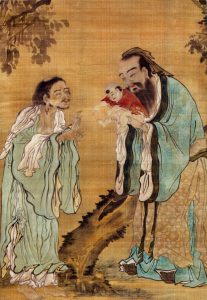East Asian Origins

The people of Ancient China, before the great traditions of Daoism, Buddhism and Confucianism emerged, already saw patterns in nature, had concepts of yin and yang, venerated their ancestors, and followed other beliefs associated with what is called “the Chinese way”. Over the centuries, both Daoism and Confucianism developed these ideas further but in different directions. Combined with Buddhism, these three traditions impacted the culture, the history and the practices of Chinese life. By the twelfth century CE, Daoism, Confucianism, and Buddhism—known as the Three Doctrines—were seen as both complementary and necessary to life in China. From that time moving forward, these three sets of doctrines often overlapped, and their rituals, architecture, and art integrated into something more than any one specific element or influence. This influence spread to southeast Asia, Japan, Korea, and eventually across the globe.
One of the earliest references to the idea of the sanjiao (literally “three teachings”) of Confucianism, Daoism, and Buddhism is attributed to Li Shiqian, a prominent scholar of the sixth century CE, who wrote that “Buddhism is the sun, Daoism the moon, and Confucianism the five planets.” [1] Today many of their ideas have migrated to other continents, been modified, and adapted to new countries and contexts.
“The three teachings are a powerful and inescapable part of Chinese religion. Whether they are eventually accepted, rejected, or reformulated, the terms of the past can only be understood by examining how they came to assume their current status. And because Chinese religion has for so long been dominated by the idea of the three teachings, it is essential to understand where those traditions come from, who constructed them and how, as well as what forms of religious life (such as those that fall under the category of “popular religion”) are omitted or denied by constructing such a picture in the first place.”[2]
Example
Take a look at this excellent summary of The Three Teachings from the Center for Global Education: China Initiative.
A little history of the era of Confucius and Lao Tzu might be helpful, even if presented in a fast and frantic way!
Green, John. “Crash Course: 2,000 Years of Chinese History! The Mandate of Heaven.” Crash Course, PBS Studios, 2012, youtu.be/ylWORyToTo4.
Asia for Educators, Columbia University. “Sanjiao: The Three Teachings.” Living in the Chinese Cosmos | Asia for Educators, 2021, afe.easia.columbia.edu/cosmos/ort/teachings.htm.
- Li’s formulation is quoted in Beishi, Li Yanshou (seventh century), Bona ed. (Beijing: Zhonghua shuju, 1974), p. 1234. Translation from Chinese by Stephen F. Teiser. ↵
- *The text of this topic, Sanjiao: The Three Teachings, was adapted, with the author’s permission, from “The Spirits of Chinese Religion,” by Stephen F. Teiser. ↵


